Comparative Analysis: Strategic Management Accounting in US and China
VerifiedAdded on 2022/09/09
|9
|2196
|20
Report
AI Summary
This report provides a comprehensive analysis of strategic management accounting, focusing on its application in both developed and developing economies, with a specific comparison between the United States (USA) and China. The study delves into the concept of strategic management accounting, emphasizing its role in data analysis and provision for business strategy development, particularly in the context of increasingly competitive business environments. The report examines the adoption of strategic management accounting tools, such as the balanced scorecard, by companies like Walmart (USA) and Alibaba (China), highlighting their distinct approaches to supply chain management and performance measurement. It illustrates how companies in developed economies leverage these tools for operational efficiency and strategic goal achievement, contrasting this with the challenges faced by companies in developing economies, such as the integration of new technologies and globalization. The analysis suggests that while strategic management accounting offers significant advantages, the implementation and focus of these tools vary between the two economies, influencing their overall impact on organizational performance and profitability. The report concludes by emphasizing the importance of adapting strategic management accounting tools to optimize supply chains and achieve strategic goals in both developed and developing contexts.
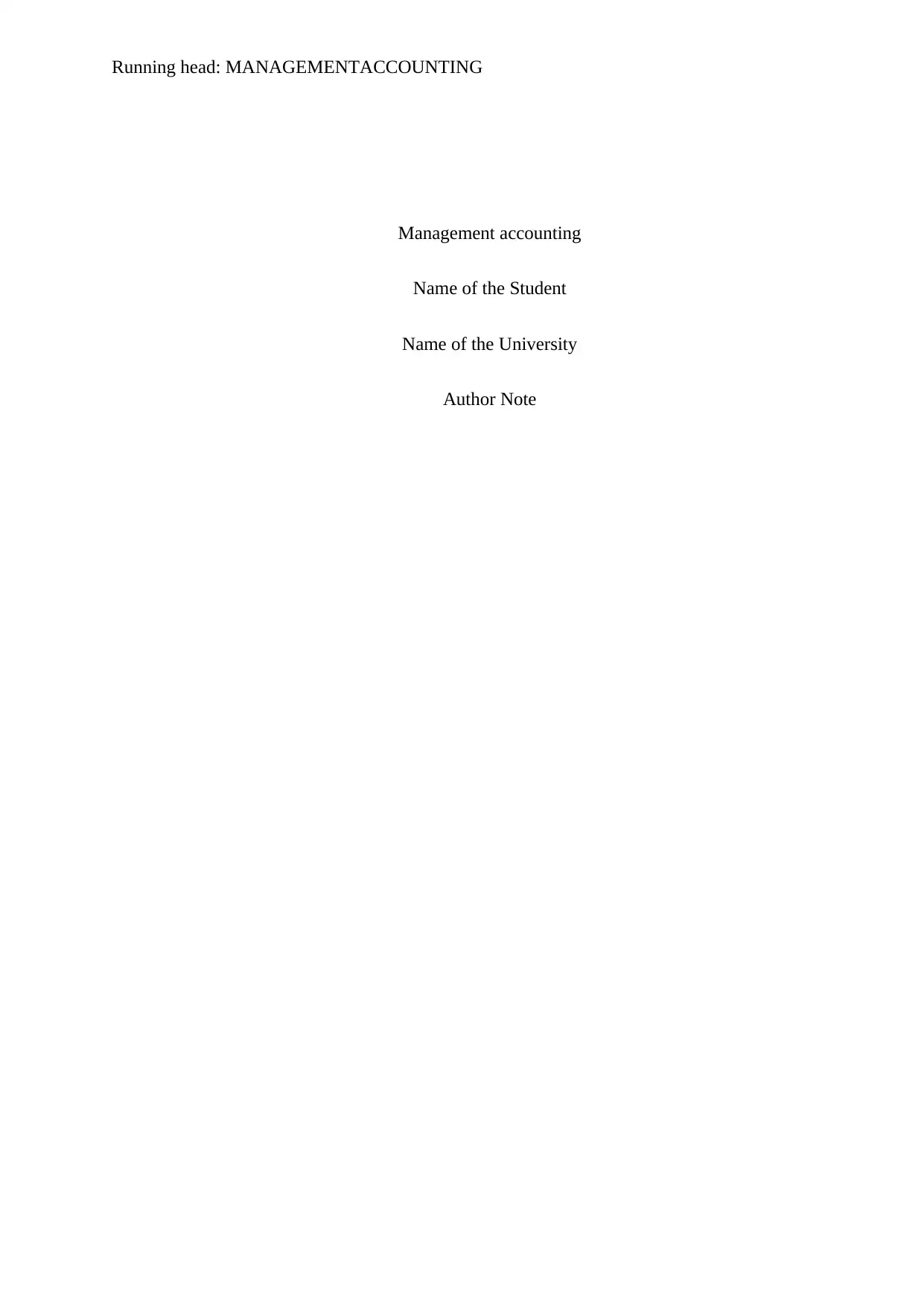
Running head: MANAGEMENTACCOUNTING
Management accounting
Name of the Student
Name of the University
Author Note
Management accounting
Name of the Student
Name of the University
Author Note
Paraphrase This Document
Need a fresh take? Get an instant paraphrase of this document with our AI Paraphraser
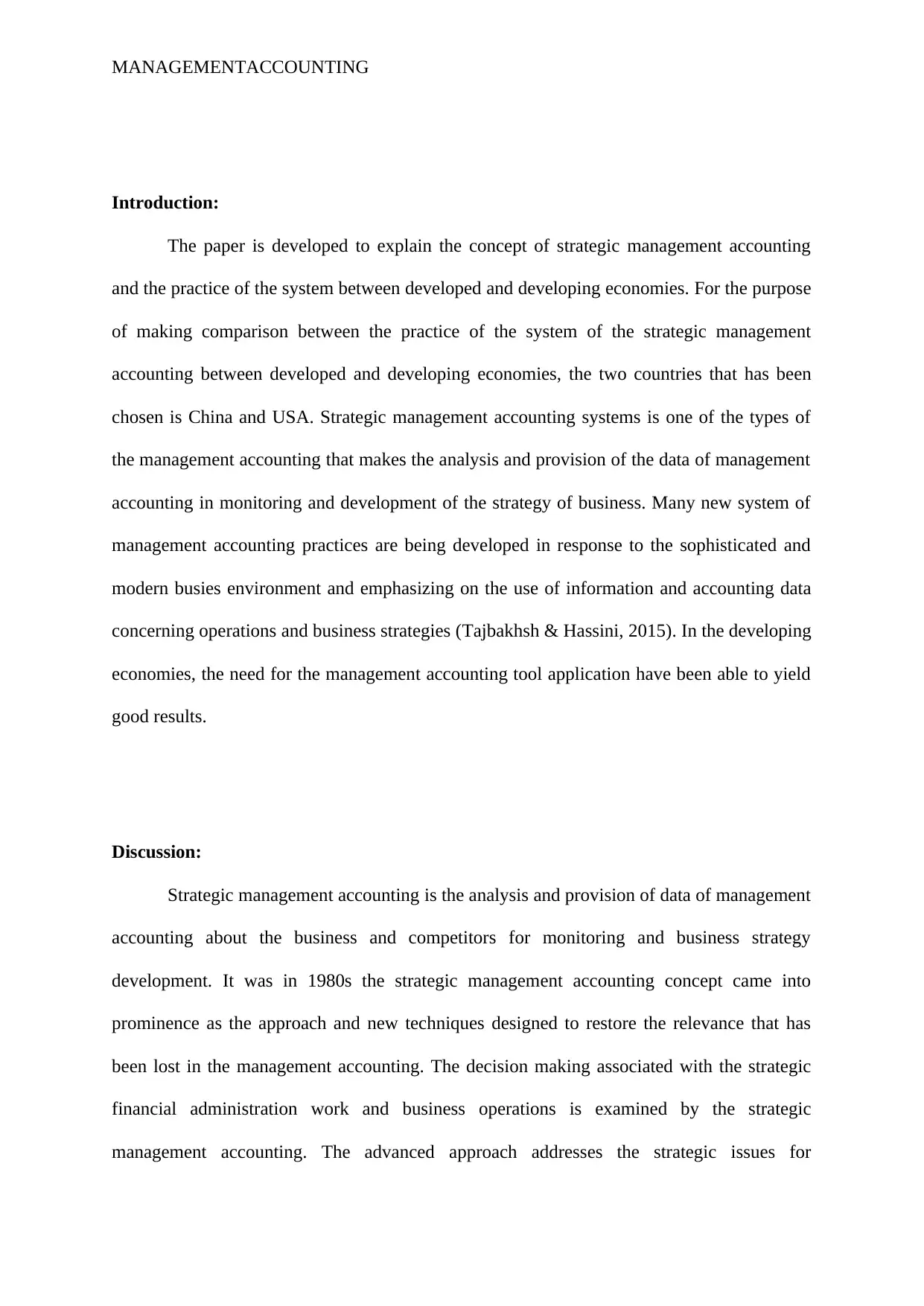
MANAGEMENTACCOUNTING
Introduction:
The paper is developed to explain the concept of strategic management accounting
and the practice of the system between developed and developing economies. For the purpose
of making comparison between the practice of the system of the strategic management
accounting between developed and developing economies, the two countries that has been
chosen is China and USA. Strategic management accounting systems is one of the types of
the management accounting that makes the analysis and provision of the data of management
accounting in monitoring and development of the strategy of business. Many new system of
management accounting practices are being developed in response to the sophisticated and
modern busies environment and emphasizing on the use of information and accounting data
concerning operations and business strategies (Tajbakhsh & Hassini, 2015). In the developing
economies, the need for the management accounting tool application have been able to yield
good results.
Discussion:
Strategic management accounting is the analysis and provision of data of management
accounting about the business and competitors for monitoring and business strategy
development. It was in 1980s the strategic management accounting concept came into
prominence as the approach and new techniques designed to restore the relevance that has
been lost in the management accounting. The decision making associated with the strategic
financial administration work and business operations is examined by the strategic
management accounting. The advanced approach addresses the strategic issues for
Introduction:
The paper is developed to explain the concept of strategic management accounting
and the practice of the system between developed and developing economies. For the purpose
of making comparison between the practice of the system of the strategic management
accounting between developed and developing economies, the two countries that has been
chosen is China and USA. Strategic management accounting systems is one of the types of
the management accounting that makes the analysis and provision of the data of management
accounting in monitoring and development of the strategy of business. Many new system of
management accounting practices are being developed in response to the sophisticated and
modern busies environment and emphasizing on the use of information and accounting data
concerning operations and business strategies (Tajbakhsh & Hassini, 2015). In the developing
economies, the need for the management accounting tool application have been able to yield
good results.
Discussion:
Strategic management accounting is the analysis and provision of data of management
accounting about the business and competitors for monitoring and business strategy
development. It was in 1980s the strategic management accounting concept came into
prominence as the approach and new techniques designed to restore the relevance that has
been lost in the management accounting. The decision making associated with the strategic
financial administration work and business operations is examined by the strategic
management accounting. The advanced approach addresses the strategic issues for
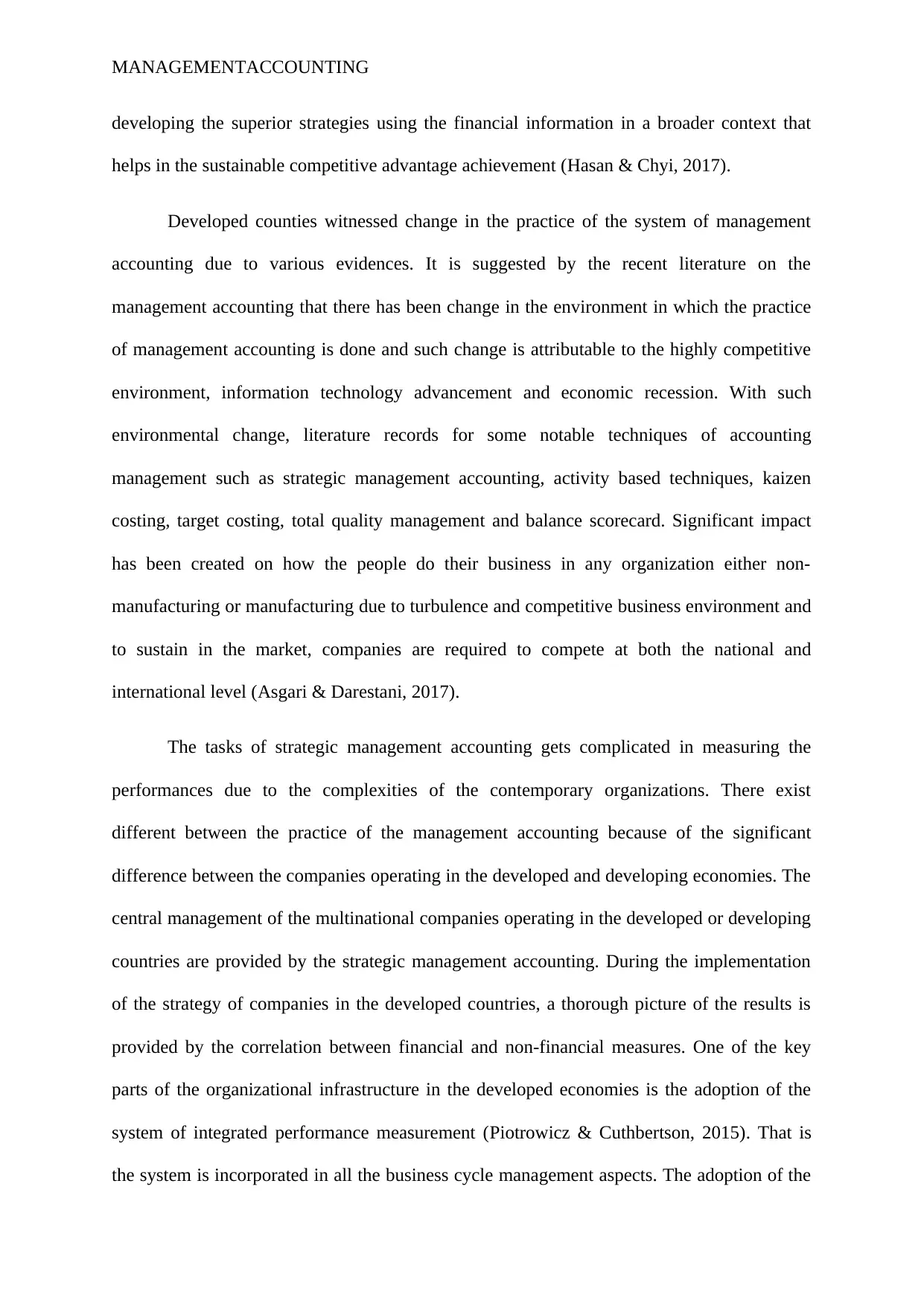
MANAGEMENTACCOUNTING
developing the superior strategies using the financial information in a broader context that
helps in the sustainable competitive advantage achievement (Hasan & Chyi, 2017).
Developed counties witnessed change in the practice of the system of management
accounting due to various evidences. It is suggested by the recent literature on the
management accounting that there has been change in the environment in which the practice
of management accounting is done and such change is attributable to the highly competitive
environment, information technology advancement and economic recession. With such
environmental change, literature records for some notable techniques of accounting
management such as strategic management accounting, activity based techniques, kaizen
costing, target costing, total quality management and balance scorecard. Significant impact
has been created on how the people do their business in any organization either non-
manufacturing or manufacturing due to turbulence and competitive business environment and
to sustain in the market, companies are required to compete at both the national and
international level (Asgari & Darestani, 2017).
The tasks of strategic management accounting gets complicated in measuring the
performances due to the complexities of the contemporary organizations. There exist
different between the practice of the management accounting because of the significant
difference between the companies operating in the developed and developing economies. The
central management of the multinational companies operating in the developed or developing
countries are provided by the strategic management accounting. During the implementation
of the strategy of companies in the developed countries, a thorough picture of the results is
provided by the correlation between financial and non-financial measures. One of the key
parts of the organizational infrastructure in the developed economies is the adoption of the
system of integrated performance measurement (Piotrowicz & Cuthbertson, 2015). That is
the system is incorporated in all the business cycle management aspects. The adoption of the
developing the superior strategies using the financial information in a broader context that
helps in the sustainable competitive advantage achievement (Hasan & Chyi, 2017).
Developed counties witnessed change in the practice of the system of management
accounting due to various evidences. It is suggested by the recent literature on the
management accounting that there has been change in the environment in which the practice
of management accounting is done and such change is attributable to the highly competitive
environment, information technology advancement and economic recession. With such
environmental change, literature records for some notable techniques of accounting
management such as strategic management accounting, activity based techniques, kaizen
costing, target costing, total quality management and balance scorecard. Significant impact
has been created on how the people do their business in any organization either non-
manufacturing or manufacturing due to turbulence and competitive business environment and
to sustain in the market, companies are required to compete at both the national and
international level (Asgari & Darestani, 2017).
The tasks of strategic management accounting gets complicated in measuring the
performances due to the complexities of the contemporary organizations. There exist
different between the practice of the management accounting because of the significant
difference between the companies operating in the developed and developing economies. The
central management of the multinational companies operating in the developed or developing
countries are provided by the strategic management accounting. During the implementation
of the strategy of companies in the developed countries, a thorough picture of the results is
provided by the correlation between financial and non-financial measures. One of the key
parts of the organizational infrastructure in the developed economies is the adoption of the
system of integrated performance measurement (Piotrowicz & Cuthbertson, 2015). That is
the system is incorporated in all the business cycle management aspects. The adoption of the
⊘ This is a preview!⊘
Do you want full access?
Subscribe today to unlock all pages.

Trusted by 1+ million students worldwide
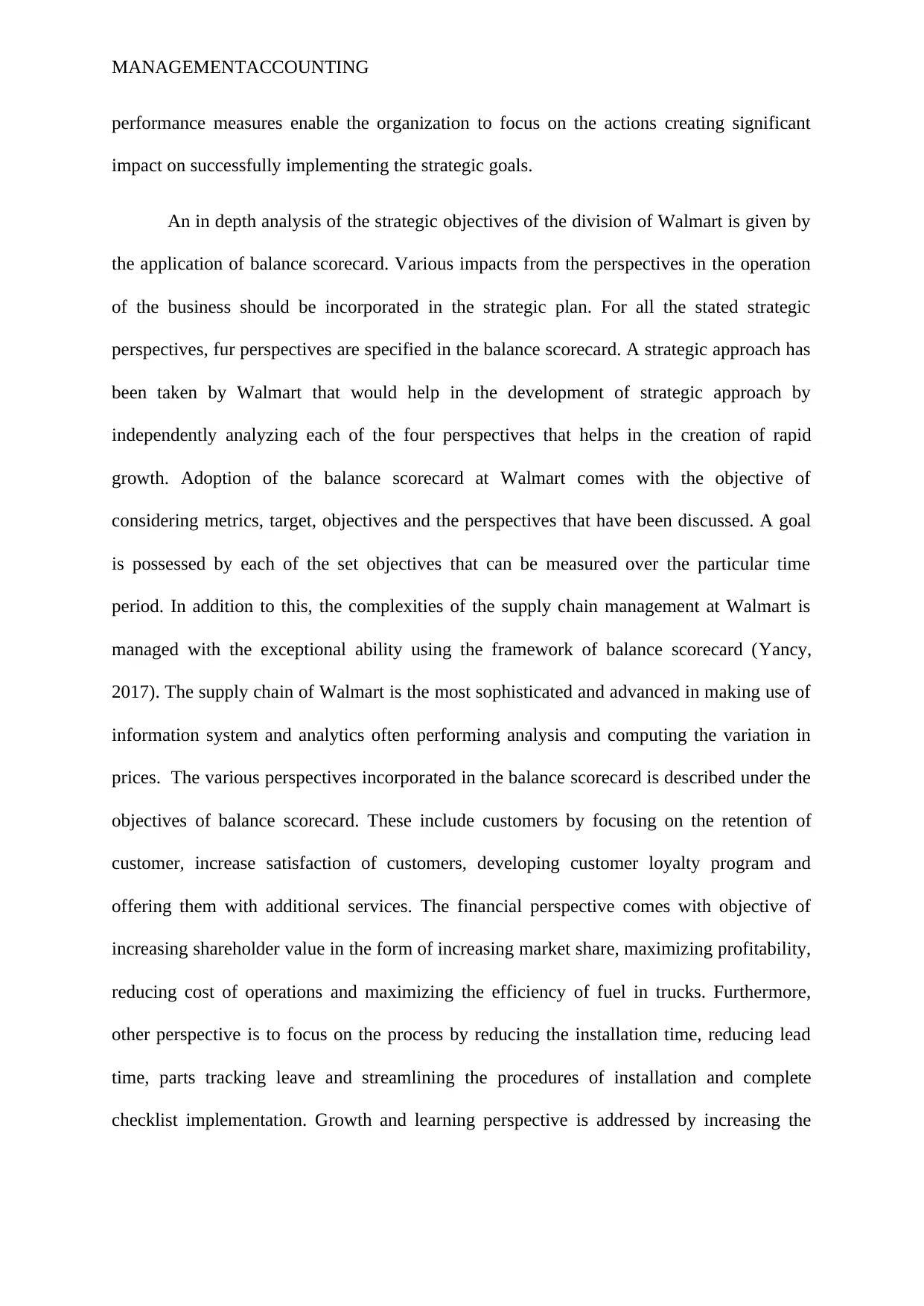
MANAGEMENTACCOUNTING
performance measures enable the organization to focus on the actions creating significant
impact on successfully implementing the strategic goals.
An in depth analysis of the strategic objectives of the division of Walmart is given by
the application of balance scorecard. Various impacts from the perspectives in the operation
of the business should be incorporated in the strategic plan. For all the stated strategic
perspectives, fur perspectives are specified in the balance scorecard. A strategic approach has
been taken by Walmart that would help in the development of strategic approach by
independently analyzing each of the four perspectives that helps in the creation of rapid
growth. Adoption of the balance scorecard at Walmart comes with the objective of
considering metrics, target, objectives and the perspectives that have been discussed. A goal
is possessed by each of the set objectives that can be measured over the particular time
period. In addition to this, the complexities of the supply chain management at Walmart is
managed with the exceptional ability using the framework of balance scorecard (Yancy,
2017). The supply chain of Walmart is the most sophisticated and advanced in making use of
information system and analytics often performing analysis and computing the variation in
prices. The various perspectives incorporated in the balance scorecard is described under the
objectives of balance scorecard. These include customers by focusing on the retention of
customer, increase satisfaction of customers, developing customer loyalty program and
offering them with additional services. The financial perspective comes with objective of
increasing shareholder value in the form of increasing market share, maximizing profitability,
reducing cost of operations and maximizing the efficiency of fuel in trucks. Furthermore,
other perspective is to focus on the process by reducing the installation time, reducing lead
time, parts tracking leave and streamlining the procedures of installation and complete
checklist implementation. Growth and learning perspective is addressed by increasing the
performance measures enable the organization to focus on the actions creating significant
impact on successfully implementing the strategic goals.
An in depth analysis of the strategic objectives of the division of Walmart is given by
the application of balance scorecard. Various impacts from the perspectives in the operation
of the business should be incorporated in the strategic plan. For all the stated strategic
perspectives, fur perspectives are specified in the balance scorecard. A strategic approach has
been taken by Walmart that would help in the development of strategic approach by
independently analyzing each of the four perspectives that helps in the creation of rapid
growth. Adoption of the balance scorecard at Walmart comes with the objective of
considering metrics, target, objectives and the perspectives that have been discussed. A goal
is possessed by each of the set objectives that can be measured over the particular time
period. In addition to this, the complexities of the supply chain management at Walmart is
managed with the exceptional ability using the framework of balance scorecard (Yancy,
2017). The supply chain of Walmart is the most sophisticated and advanced in making use of
information system and analytics often performing analysis and computing the variation in
prices. The various perspectives incorporated in the balance scorecard is described under the
objectives of balance scorecard. These include customers by focusing on the retention of
customer, increase satisfaction of customers, developing customer loyalty program and
offering them with additional services. The financial perspective comes with objective of
increasing shareholder value in the form of increasing market share, maximizing profitability,
reducing cost of operations and maximizing the efficiency of fuel in trucks. Furthermore,
other perspective is to focus on the process by reducing the installation time, reducing lead
time, parts tracking leave and streamlining the procedures of installation and complete
checklist implementation. Growth and learning perspective is addressed by increasing the
Paraphrase This Document
Need a fresh take? Get an instant paraphrase of this document with our AI Paraphraser
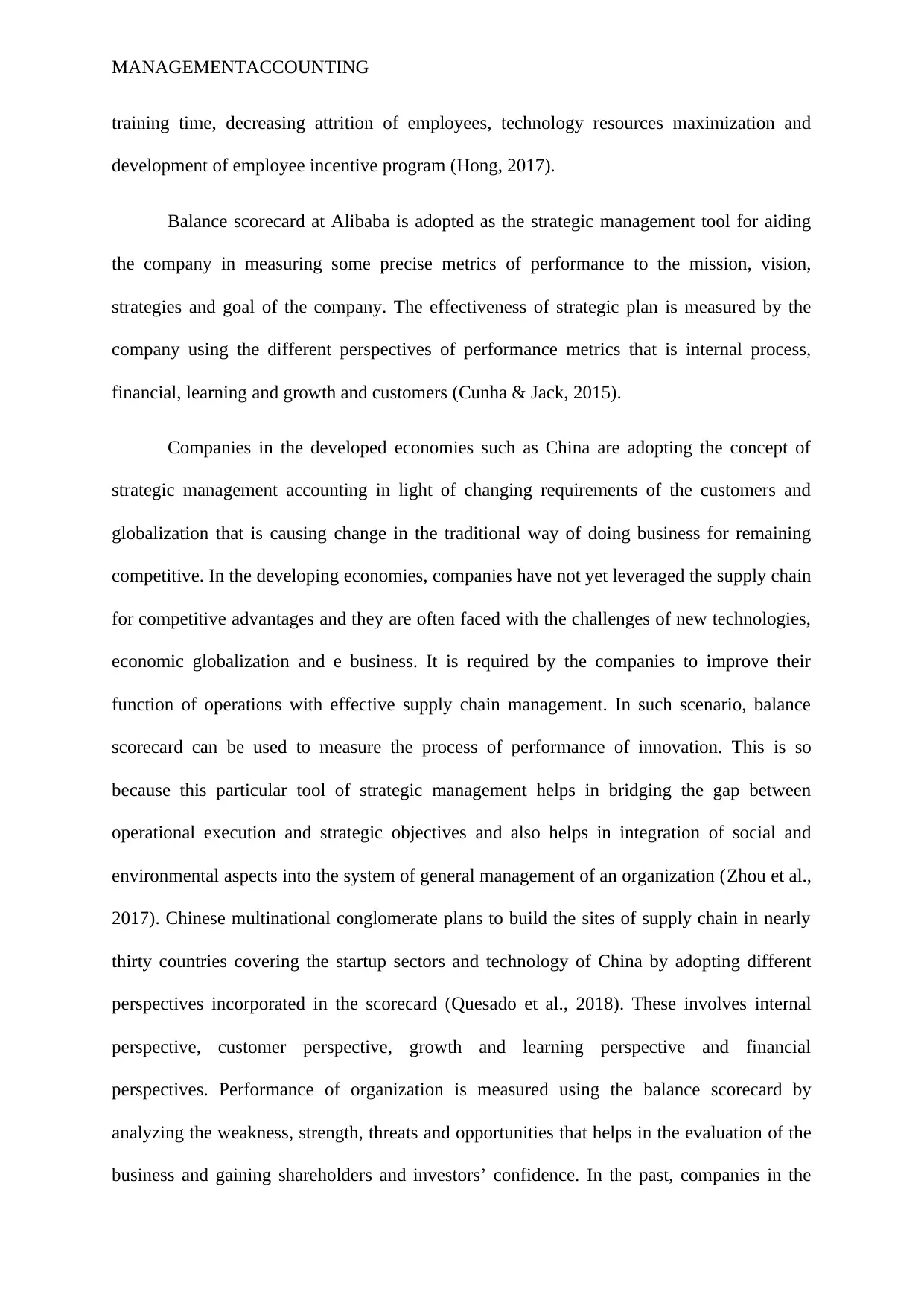
MANAGEMENTACCOUNTING
training time, decreasing attrition of employees, technology resources maximization and
development of employee incentive program (Hong, 2017).
Balance scorecard at Alibaba is adopted as the strategic management tool for aiding
the company in measuring some precise metrics of performance to the mission, vision,
strategies and goal of the company. The effectiveness of strategic plan is measured by the
company using the different perspectives of performance metrics that is internal process,
financial, learning and growth and customers (Cunha & Jack, 2015).
Companies in the developed economies such as China are adopting the concept of
strategic management accounting in light of changing requirements of the customers and
globalization that is causing change in the traditional way of doing business for remaining
competitive. In the developing economies, companies have not yet leveraged the supply chain
for competitive advantages and they are often faced with the challenges of new technologies,
economic globalization and e business. It is required by the companies to improve their
function of operations with effective supply chain management. In such scenario, balance
scorecard can be used to measure the process of performance of innovation. This is so
because this particular tool of strategic management helps in bridging the gap between
operational execution and strategic objectives and also helps in integration of social and
environmental aspects into the system of general management of an organization (Zhou et al.,
2017). Chinese multinational conglomerate plans to build the sites of supply chain in nearly
thirty countries covering the startup sectors and technology of China by adopting different
perspectives incorporated in the scorecard (Quesado et al., 2018). These involves internal
perspective, customer perspective, growth and learning perspective and financial
perspectives. Performance of organization is measured using the balance scorecard by
analyzing the weakness, strength, threats and opportunities that helps in the evaluation of the
business and gaining shareholders and investors’ confidence. In the past, companies in the
training time, decreasing attrition of employees, technology resources maximization and
development of employee incentive program (Hong, 2017).
Balance scorecard at Alibaba is adopted as the strategic management tool for aiding
the company in measuring some precise metrics of performance to the mission, vision,
strategies and goal of the company. The effectiveness of strategic plan is measured by the
company using the different perspectives of performance metrics that is internal process,
financial, learning and growth and customers (Cunha & Jack, 2015).
Companies in the developed economies such as China are adopting the concept of
strategic management accounting in light of changing requirements of the customers and
globalization that is causing change in the traditional way of doing business for remaining
competitive. In the developing economies, companies have not yet leveraged the supply chain
for competitive advantages and they are often faced with the challenges of new technologies,
economic globalization and e business. It is required by the companies to improve their
function of operations with effective supply chain management. In such scenario, balance
scorecard can be used to measure the process of performance of innovation. This is so
because this particular tool of strategic management helps in bridging the gap between
operational execution and strategic objectives and also helps in integration of social and
environmental aspects into the system of general management of an organization (Zhou et al.,
2017). Chinese multinational conglomerate plans to build the sites of supply chain in nearly
thirty countries covering the startup sectors and technology of China by adopting different
perspectives incorporated in the scorecard (Quesado et al., 2018). These involves internal
perspective, customer perspective, growth and learning perspective and financial
perspectives. Performance of organization is measured using the balance scorecard by
analyzing the weakness, strength, threats and opportunities that helps in the evaluation of the
business and gaining shareholders and investors’ confidence. In the past, companies in the

MANAGEMENTACCOUNTING
developing economies failed to establish the association between the short term actions and
long term strategy and this caused the gap between the strategic development of plan and the
implementation (Khan et al., 2016). The adoption of balance scorecard resulted in solving
this problem.
From the analysis of the given cases of the adoption of tool of strategic management
in the developed and developing economies, it has been found that more than half of the
firms operating in US have adopted the strategic management accounting system, whereas in
the developing economies such as China, some of the major companies have adopted the
approach of strategic management accounting and making balance scorecard as the widely
used tool (Valmohammadi & Ahmadi, 2015). It has been ascertained from some research
conducted that the companies adopting the approach have witnessed an improvement in their
operations. However, unlike the companies in developed economies such as USA that make
use of strategic management accounting tools for making their supply chain optimal by way
of improving their efficiency. It is also required by the companies in the developing countries
should stride towards making their supply chain optimal by the adoption of tool like balance
scorecard. The adoption of the tool of strategic management accounting would assist the
organizations in developing countries to achieve profitability in their supply chain (Marković
& Stevanović, 2014).
Conclusion:
The paper has addressed the detailed analysis of the system of strategic management
accounting in both the developed and developing economies. It has been determined from the
research conducted that the tools of strategic management accounting offers companies with
various advantages in their operations. However, there exist the difference between the
cultures of the implementation of the strategic management tool between developed and
developing economies failed to establish the association between the short term actions and
long term strategy and this caused the gap between the strategic development of plan and the
implementation (Khan et al., 2016). The adoption of balance scorecard resulted in solving
this problem.
From the analysis of the given cases of the adoption of tool of strategic management
in the developed and developing economies, it has been found that more than half of the
firms operating in US have adopted the strategic management accounting system, whereas in
the developing economies such as China, some of the major companies have adopted the
approach of strategic management accounting and making balance scorecard as the widely
used tool (Valmohammadi & Ahmadi, 2015). It has been ascertained from some research
conducted that the companies adopting the approach have witnessed an improvement in their
operations. However, unlike the companies in developed economies such as USA that make
use of strategic management accounting tools for making their supply chain optimal by way
of improving their efficiency. It is also required by the companies in the developing countries
should stride towards making their supply chain optimal by the adoption of tool like balance
scorecard. The adoption of the tool of strategic management accounting would assist the
organizations in developing countries to achieve profitability in their supply chain (Marković
& Stevanović, 2014).
Conclusion:
The paper has addressed the detailed analysis of the system of strategic management
accounting in both the developed and developing economies. It has been determined from the
research conducted that the tools of strategic management accounting offers companies with
various advantages in their operations. However, there exist the difference between the
cultures of the implementation of the strategic management tool between developed and
⊘ This is a preview!⊘
Do you want full access?
Subscribe today to unlock all pages.

Trusted by 1+ million students worldwide
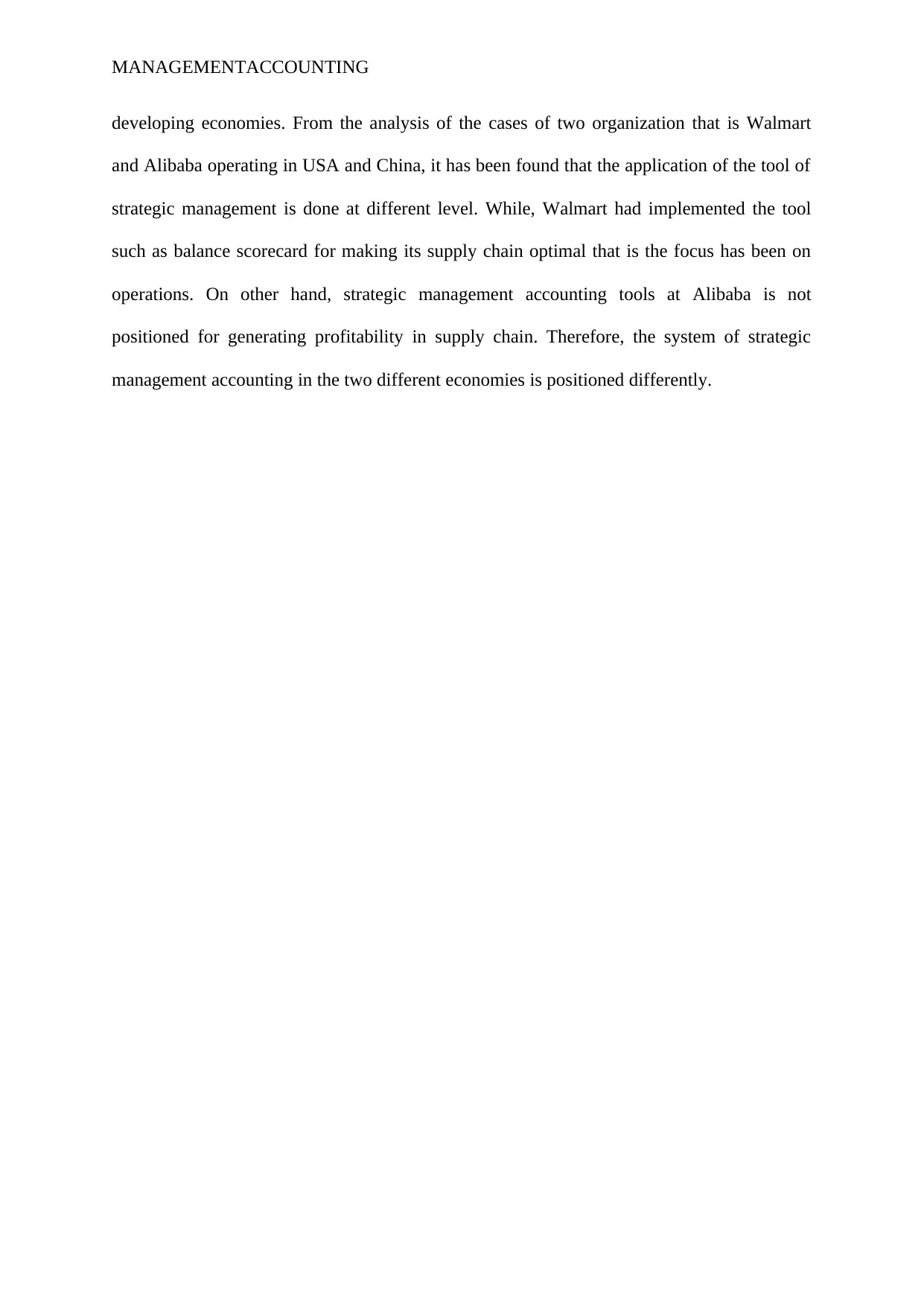
MANAGEMENTACCOUNTING
developing economies. From the analysis of the cases of two organization that is Walmart
and Alibaba operating in USA and China, it has been found that the application of the tool of
strategic management is done at different level. While, Walmart had implemented the tool
such as balance scorecard for making its supply chain optimal that is the focus has been on
operations. On other hand, strategic management accounting tools at Alibaba is not
positioned for generating profitability in supply chain. Therefore, the system of strategic
management accounting in the two different economies is positioned differently.
developing economies. From the analysis of the cases of two organization that is Walmart
and Alibaba operating in USA and China, it has been found that the application of the tool of
strategic management is done at different level. While, Walmart had implemented the tool
such as balance scorecard for making its supply chain optimal that is the focus has been on
operations. On other hand, strategic management accounting tools at Alibaba is not
positioned for generating profitability in supply chain. Therefore, the system of strategic
management accounting in the two different economies is positioned differently.
Paraphrase This Document
Need a fresh take? Get an instant paraphrase of this document with our AI Paraphraser
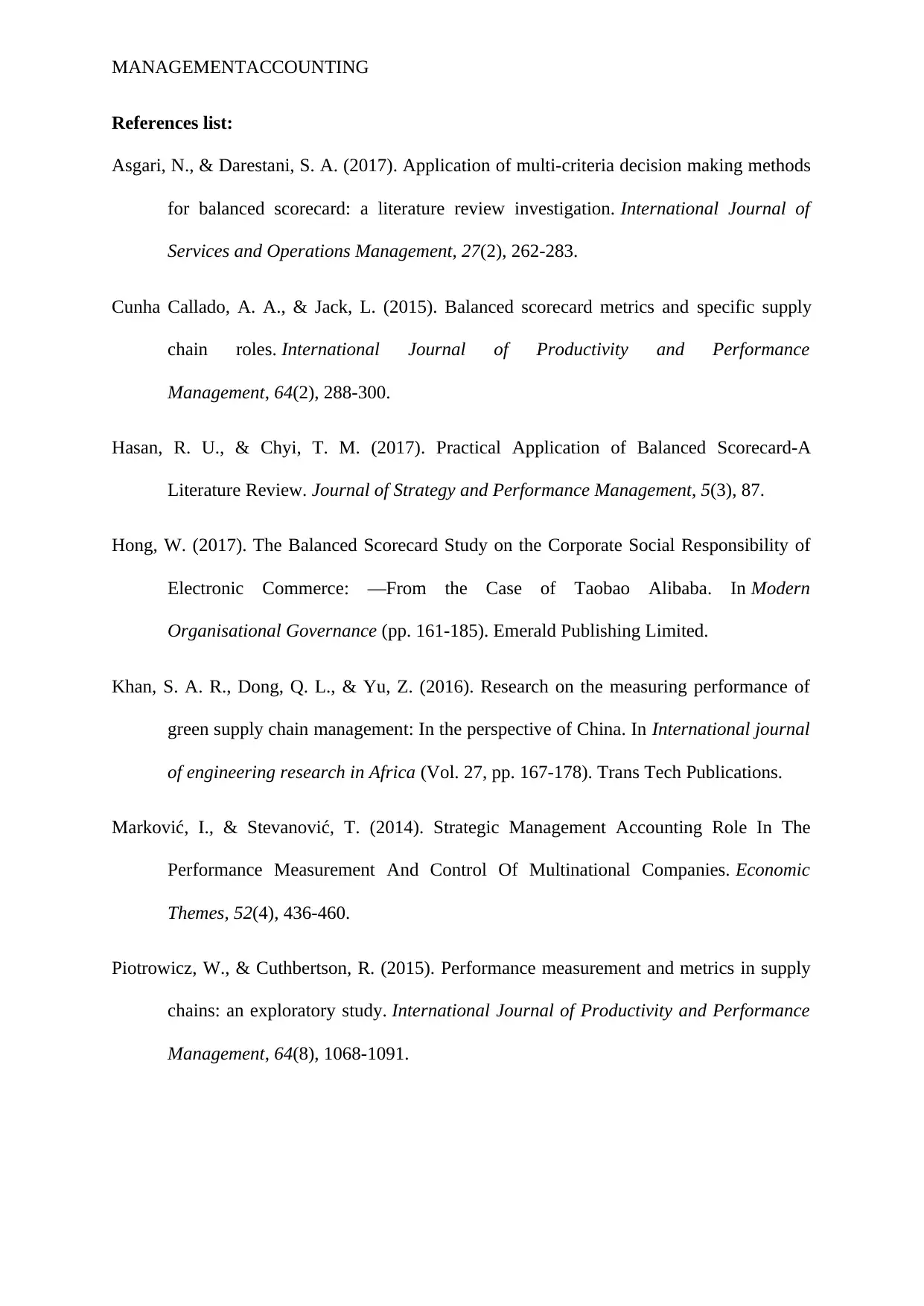
MANAGEMENTACCOUNTING
References list:
Asgari, N., & Darestani, S. A. (2017). Application of multi-criteria decision making methods
for balanced scorecard: a literature review investigation. International Journal of
Services and Operations Management, 27(2), 262-283.
Cunha Callado, A. A., & Jack, L. (2015). Balanced scorecard metrics and specific supply
chain roles. International Journal of Productivity and Performance
Management, 64(2), 288-300.
Hasan, R. U., & Chyi, T. M. (2017). Practical Application of Balanced Scorecard-A
Literature Review. Journal of Strategy and Performance Management, 5(3), 87.
Hong, W. (2017). The Balanced Scorecard Study on the Corporate Social Responsibility of
Electronic Commerce: —From the Case of Taobao Alibaba. In Modern
Organisational Governance (pp. 161-185). Emerald Publishing Limited.
Khan, S. A. R., Dong, Q. L., & Yu, Z. (2016). Research on the measuring performance of
green supply chain management: In the perspective of China. In International journal
of engineering research in Africa (Vol. 27, pp. 167-178). Trans Tech Publications.
Marković, I., & Stevanović, T. (2014). Strategic Management Accounting Role In The
Performance Measurement And Control Of Multinational Companies. Economic
Themes, 52(4), 436-460.
Piotrowicz, W., & Cuthbertson, R. (2015). Performance measurement and metrics in supply
chains: an exploratory study. International Journal of Productivity and Performance
Management, 64(8), 1068-1091.
References list:
Asgari, N., & Darestani, S. A. (2017). Application of multi-criteria decision making methods
for balanced scorecard: a literature review investigation. International Journal of
Services and Operations Management, 27(2), 262-283.
Cunha Callado, A. A., & Jack, L. (2015). Balanced scorecard metrics and specific supply
chain roles. International Journal of Productivity and Performance
Management, 64(2), 288-300.
Hasan, R. U., & Chyi, T. M. (2017). Practical Application of Balanced Scorecard-A
Literature Review. Journal of Strategy and Performance Management, 5(3), 87.
Hong, W. (2017). The Balanced Scorecard Study on the Corporate Social Responsibility of
Electronic Commerce: —From the Case of Taobao Alibaba. In Modern
Organisational Governance (pp. 161-185). Emerald Publishing Limited.
Khan, S. A. R., Dong, Q. L., & Yu, Z. (2016). Research on the measuring performance of
green supply chain management: In the perspective of China. In International journal
of engineering research in Africa (Vol. 27, pp. 167-178). Trans Tech Publications.
Marković, I., & Stevanović, T. (2014). Strategic Management Accounting Role In The
Performance Measurement And Control Of Multinational Companies. Economic
Themes, 52(4), 436-460.
Piotrowicz, W., & Cuthbertson, R. (2015). Performance measurement and metrics in supply
chains: an exploratory study. International Journal of Productivity and Performance
Management, 64(8), 1068-1091.
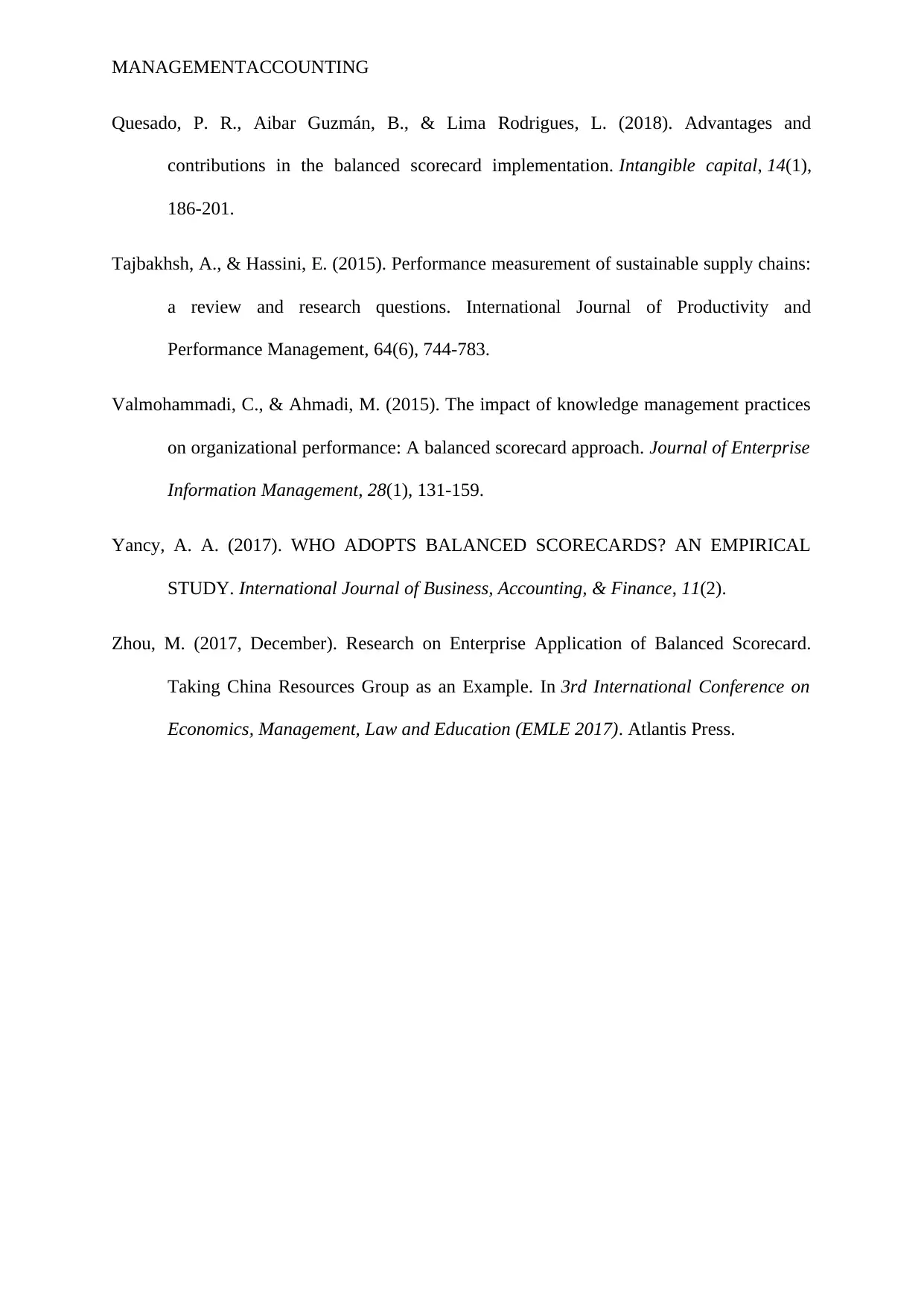
MANAGEMENTACCOUNTING
Quesado, P. R., Aibar Guzmán, B., & Lima Rodrigues, L. (2018). Advantages and
contributions in the balanced scorecard implementation. Intangible capital, 14(1),
186-201.
Tajbakhsh, A., & Hassini, E. (2015). Performance measurement of sustainable supply chains:
a review and research questions. International Journal of Productivity and
Performance Management, 64(6), 744-783.
Valmohammadi, C., & Ahmadi, M. (2015). The impact of knowledge management practices
on organizational performance: A balanced scorecard approach. Journal of Enterprise
Information Management, 28(1), 131-159.
Yancy, A. A. (2017). WHO ADOPTS BALANCED SCORECARDS? AN EMPIRICAL
STUDY. International Journal of Business, Accounting, & Finance, 11(2).
Zhou, M. (2017, December). Research on Enterprise Application of Balanced Scorecard.
Taking China Resources Group as an Example. In 3rd International Conference on
Economics, Management, Law and Education (EMLE 2017). Atlantis Press.
Quesado, P. R., Aibar Guzmán, B., & Lima Rodrigues, L. (2018). Advantages and
contributions in the balanced scorecard implementation. Intangible capital, 14(1),
186-201.
Tajbakhsh, A., & Hassini, E. (2015). Performance measurement of sustainable supply chains:
a review and research questions. International Journal of Productivity and
Performance Management, 64(6), 744-783.
Valmohammadi, C., & Ahmadi, M. (2015). The impact of knowledge management practices
on organizational performance: A balanced scorecard approach. Journal of Enterprise
Information Management, 28(1), 131-159.
Yancy, A. A. (2017). WHO ADOPTS BALANCED SCORECARDS? AN EMPIRICAL
STUDY. International Journal of Business, Accounting, & Finance, 11(2).
Zhou, M. (2017, December). Research on Enterprise Application of Balanced Scorecard.
Taking China Resources Group as an Example. In 3rd International Conference on
Economics, Management, Law and Education (EMLE 2017). Atlantis Press.
⊘ This is a preview!⊘
Do you want full access?
Subscribe today to unlock all pages.

Trusted by 1+ million students worldwide
1 out of 9
Related Documents
Your All-in-One AI-Powered Toolkit for Academic Success.
+13062052269
info@desklib.com
Available 24*7 on WhatsApp / Email
![[object Object]](/_next/static/media/star-bottom.7253800d.svg)
Unlock your academic potential
Copyright © 2020–2025 A2Z Services. All Rights Reserved. Developed and managed by ZUCOL.




